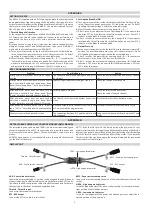
8
Under full power the torque effect will attempt to gently turn the
wing, adjusting the trims or using weightshift is the best method to
correct this.
The handling characteristic of the Viper 2 is truly amazing. We
have worked hard on tuning the wing so that it turns tightly but
also efficiently, as the ability to climb in a turn is very important for
powered and free flight, making the climb out fun and thermalling
easy.
Normal Flight
Once at a safe altitude you can release the trims for a faster cruise
speed. The Viper 2 will achieve very good straight line speed (i.e
maintaining level flight) with trims fully released and full speed bar
applied.
For better penetration in headwinds and improved glide perfor
-
mance in sinking air, crosswinds or headwinds, you should fly
faster than trim speed by using the accelerator system. For maxi
-
mum efficiency whilst flying downwind, release the speed bar and
pull the trims to the slow position.
By pulling the trimmers to the slow position and applying the
brakes approximately 30cm, the Viper 2 will achieve its minimum-
sink rate; this is the speed for best climb and is the speed to use
for thermalling and ridge soaring.
Turning
To familiarize yourself with the Viper 2 your first turns should be
gradual and progressive.
To make efficient and coordinated turns with the Viper 2 first look
in the direction you want to go and check that the airspace is
clear. Your first input for directional change should be weight-shift,
followed by the smooth application of the brake until the desired
bank angle is achieved. To regulate the speed and radius of the
turn, coordinate your weight shift and use the outer brake.
Reverse Launch -Light to Strong Winds
Lay out your Viper 2 as you would for the forward launch. However,
this time face the wing, and attach the risers in the correct manor
(half a turn in each riser, and crossed in the direction you want to
turn). Now you can pull up the Viper 2 by its A-risers. Once the
wing is overhead, brake it gently, turn and launch.
In stronger winds, be prepared to take a few steps towards the
glider as it inflates. This will take some of the energy out of the
glider and it will be less likely to over-fly you. Once stable and
above your head apply progressive power and accelerate smoothly
for a controlled take off.
IMPORTANT: Never attempt to take off with a glider that is
not fully inflated, directly overhead or if you are not fully in
control of the pitch/roll of the wing.
Practice ground handling and launching as much as possible! It is
great fun, and will give you a much better feel for your Viper 2s
flight characteristics. It will also improve your overall enjoyment of
flying by making your launches easier and safer.
The Climb Out
Once in the air you should continue flying into wind gain altitude.
By using slow trim and a small amount of brake you will achieve
the best climb rate. Do not attempt to climb too steeply, too
quickly. The high angle of attack will make the glider more prone
to stall and in the event of an engine failure the pendulum effect
may bring you to the ground very hard. Do not initiate turns until
you have sufficient height and airspeed. Avoid low turns downwind
with insufficient airspeed.
The Viper 2 is well damped in roll but under certain circumstances
it is possible for the pilot to induce oscillations. This is caused by
a combination of the engine/propeller torque and pilot weightshift
and/or brake inputs. To stop oscillations it is best to reduce the
power slightly and ensure that you remain static with weight
-
shift and brake inputs. Once settled you can once again apply full
power.
Summary of Contents for Viper 2 24
Page 1: ......
Page 2: ...YOUR WING IS HERE ...
Page 4: ......
Page 19: ...17 ENGLISH ...
Page 20: ......
Page 37: ...35 FRANCAIS ...
Page 38: ......
Page 60: ......











































